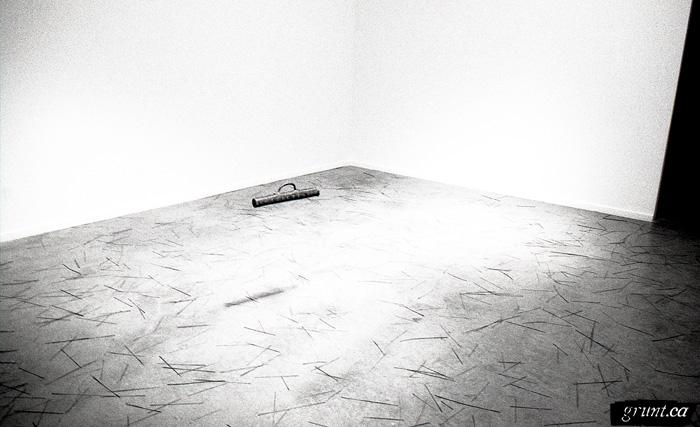Daniel Olson - Collection
January 1996
Daniel Olson wasn't your typical kid: he never found satisfaction in collecting your usual assortment of boys knickknacks. Stamps and baseball cards never did it for him - but years later, the seemingly unwanted things did. He began noticing “bits of debris from the side of the road”: always stumbling upon these abandoned wonders, Olson created a leather collecting tool, filled it with a metal pipe, and stenciled “COLLECTION” on it. According to Olson, “the street becomes a studio [and] the junk of urban life the artist’s materials.”
“Mainly, what I am doing is making a source of perplexity into an activity that passes the time pleasurably”.
from Artist’s Statement - Collection, Daniel Olson (some paraphrased)


Video
Description:
The artist plays a wind instrument in a bare concrete room. He is then seen building a custom instrument from a music box, then playing it through an amplifier in a building lobby.
Broadband Video for high speed connections
57:18/460MB
Dialup Video for modem/slow connections
57:18/41MB
Essay
Daniel Olson's installation, Collection, is about collecting, the simple act of ordering groups of objects into a single entity—the metal strips scattered across the gallery floor, brush bristles from city’s street cleaning equipment that Olson collects on walks through Toronto. The pieces are gathered in a leather case with its title stenciled on, that hangs in the centre of the space. By bringing them together in the gallery, Olson imbues the objects with a 'value' though it isn't clear what that 'value' actually is. But it is obvious the transmutation Olson attempts asks more questions than it answers.
Collections also represent, often on several levels at once. Coins represent the eras and nations in which they were minted. Art collections represent power and ownership both when they were produced and in the present. But when one thinks of collections it is usually their differences that hold our attention. Minuscule changes in date and decoration make one coin valuable and another worthless. Is Olson suggesting we study the differences in these bristles as some sort of Zen exercise? Absorb ourselves in the wear on the metal and the rust? But their patina doesn't warrant the close inspection; it is just banal.
Walking in the urban setting is an act that isn't given much value in urban living. Not quite leisure, and certainly not work, one questions its necessity at all. To say you spent the day 'walking around' is an admission of not doing anything, or at least nothing productive. Collection, as much as than anything else, represents the artist's love for walking in the urban environment for all of its banality. Olson's references to ready-mades and scatter art are a strategy within the transmutation. Art history gives him the authority to combine a useless activity with a valueless object into a slightly more profitable enterprise—art.
The twin systems of mathematics and music are part of the theoretical base that fuels Olson's work. Olson started in mathematics and the Duchampian formula 'Let X = ?' is very much his entry into art. But as a mathematician Olson is interested in only the simplest of arithmetic: addition, subtraction, and in Collection, multiplication. In music it is the same story. The primitive music boxes he fashions out of children's toys deal in the basic scale of whole notes or in no scale at all. The two systems are kept simple because to complicate them would be to move away from the theoretical, something Olson seems reluctant to do. The idea of mathematics or music is enough.
In Collection Olson mimics his subject. Collections begin with the love of an object and the act of bringing them together. The purpose of collections is all about enhanced value; one power of any collection is to tell us far more than expected at first glance. Olson's salvaging of the bristles starts from his enjoyment of an activity and the enhancement of that activity through collecting. He succeeds in giving these objects 'value' just by virtue of our attention, and by bringing the street into the gallery; the daily penury of the urban environment is brought home. In the end this work is about the collecting of the pieces. Olson's walks are turned into impromptu performances. His practice places art within the anonymous urban landscape outside the protection of the institutions. These performances, much like their product, situate themselves in the mundane.
"What are you doing?"
"Why?"
-Glenn Alteen, January 1996



